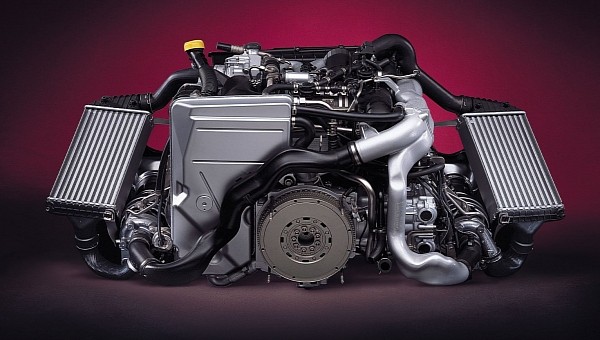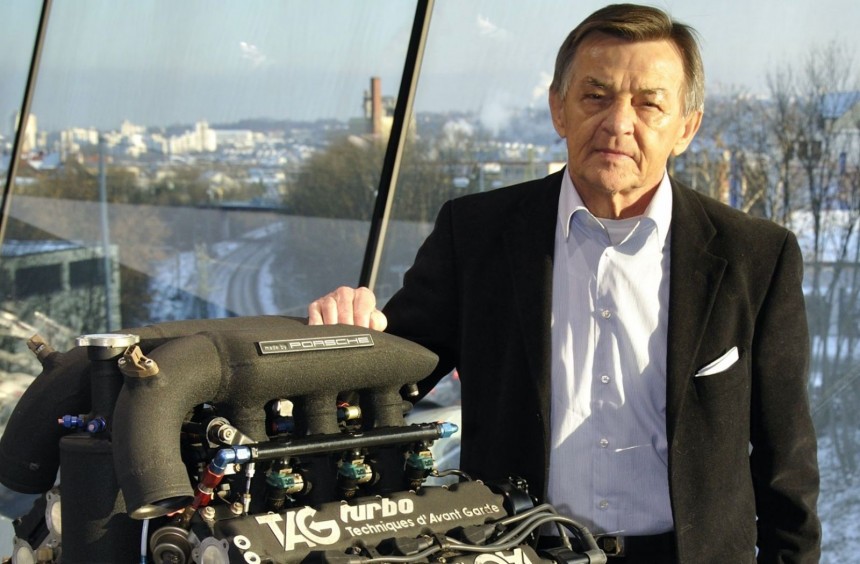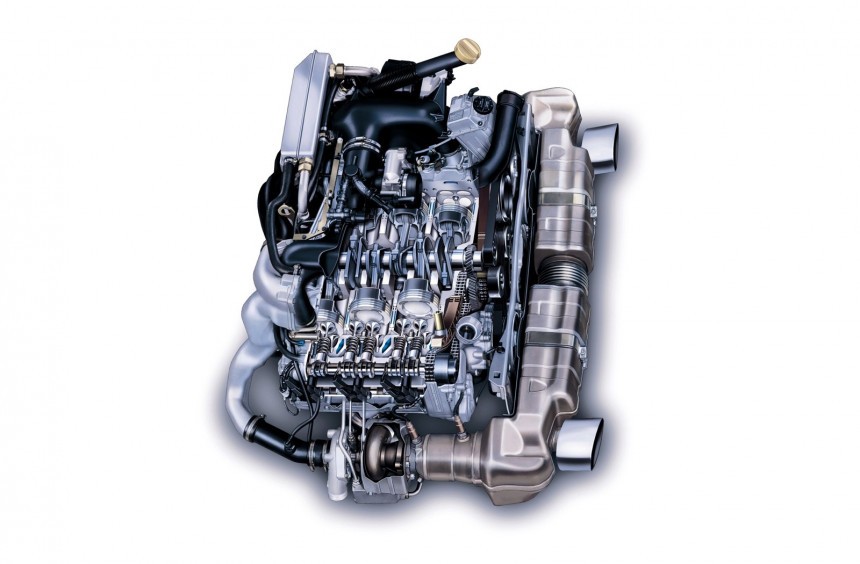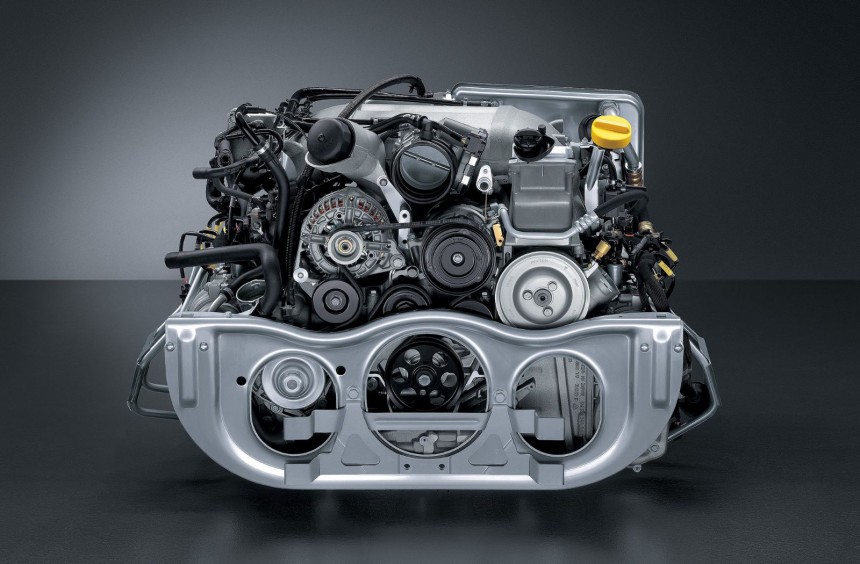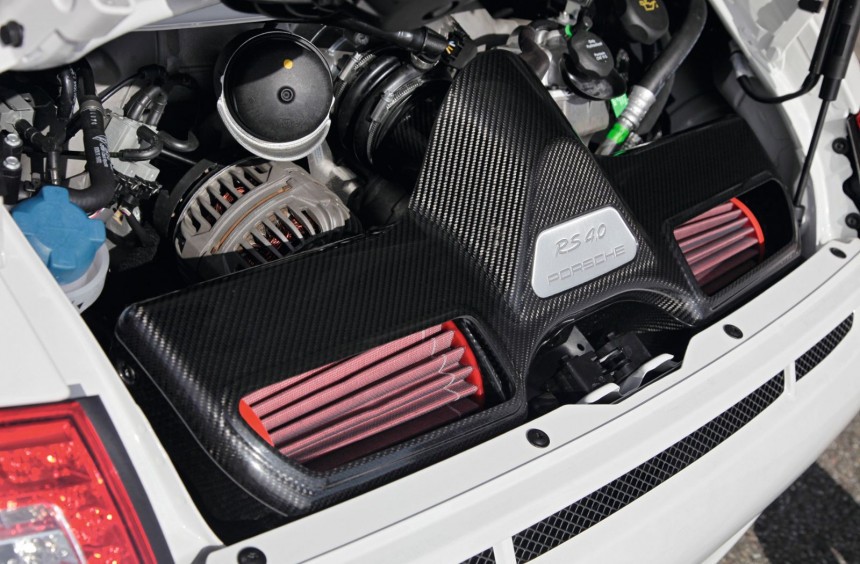Available in both naturally-aspirated and twin-turbocharged forms, the so-called “Mezger engine” was Porsche’s most impressive road-legal powerplant for nearly fifteen years.
Hans Mezger was probably the most important individual that ever worked for Porsche. After graduating from the Stuttgart Technical University in 1956, he joined Porsche and, until 1994 when he retired, the legendary engineer played a key role in the development of the carmaker’s most iconic powerplants.
The long list of Mezger-designed engines includes the production flat-six that powered the first 911 and all future air-cooled generations, the Type 912 flat-twelve of the Le Mans-winning 917, or the TTE PO1 V6 at the heart of the McLaren MP4/2 which dominated Formula 1 in 1984.
So basically, nearly all of Porsche’s motors developed from the 1960s to the early-1990s were, to some extent, Mezger engines. That leads to the following question: why is the unit that debuted in the first GT3 (996) and its subsequent versions known as “Mezger engines”, especially since they were developed after the engineer had retired?
Well, the Porsche community started using this moniker to differentiate these engines from the problematic, water-cooled units of the 996 and 997 911 Carreras. Though also water-cooled, the so-called “Mezger engines” were based on a different architecture that traces its roots to innovations pioneered by Hans Mezger.
From the 2.0-liter inside the first 911 to the units that powered the 993 model range, Porsche used the same basic air-cooled flat-six design that was continually improved. But, for the 996 range that hit the streets in 1997, the carmaker decided to break with tradition by introducing an all-new, water-cooled six dubbed M96.
Unfortunately, this engine featured several serious design flaws, leading to many reliability issues. These include cylinders prone to cracking and scoring, a leaking rear main seal, or the most dreaded of them all: an intermediate shaft bearing with the habit of failing.
So, when it was time to homologate the 996 for GT3 regulations, Porsche was faced with a big problem. The M96 was clearly not up to the task and a complete redesign that would address its many weaknesses would have required too much time to complete.
Thus, they decided to build a different engine based on the racing unit used in the 1998 Le Mans-winning GT1-98. Several parts of this powerplant were based on those used in the iconic 959s flat-six, an engine designed by Hans Mezger during the mid-1980s. Complicated, I know but that’s why the resulting GT3 motor became known as the Mezger engine. If my explanation is not clear enough, I recommend watching the YouTube video below by JayEmm on Cars.
Codenamed M96.79, the first iteration of the Mezger debuted in 1999 when the first 911 GT3 was introduced. Displacing 3.6 liters, the naturally-aspirated flat-six used a block with water-cooled cylinders similar in design to that of the GT1-98 and one-piece, four-valve cylinder heads that were also water-cooled. The design of these heads can be traced back to the 959, but they were more closely related in terms of overall architecture to the units of the Le Mans-wining GT1-98 race car.
Moreover, the new GT3 engine used a true dry-sump crankcase with an external oil reservoir, unlike the M96 found in the 996 Carrera which came with a so-called “integrated dry-sump system” that in reality was just a modified wet sump with a two-piece crankcase design.
Only available with a good old-fashioned manual transmission (six-speed), the M96.79 was initially rated at a healthy 355 hp (360 ps). Output rose to 375 hp (381 ps) in the revised 996.2 GT3. With upgraded cylinder heads, the engine also powered the first GT3 RS. Porsche claimed the same 375 hp (381 ps) output as the standard 996.2 GT3, when put on a dyno, the powerplant edged closer to the 400 hp (407 ps) mark.
Apart from the GT3 range, the first Mezger also powered the 996 versions of the all-wheel-drive 911 Turbo and the rear-wheel-drive 911 GT2. In these models, it received a twin-turbo system which enabled it to make between 414 hp (420 ps) and 476 hp (483 ps).
In 2004, the German carmaker unveiled the new 911 range, internally designated 997. Gone were those dreadful “fried egg” headlights that made the 996 so unpopular among Porsche purists but when it came to GT3, GT2, and Turbo models, the Mezger engine made a comeback.
Initially, it continued to displace 3.6 liters, engineers enlarged it to 3.8 liters in 2009, then all the way up to 4.0 liters three years later, in the 997.2 GT3 RS 4.0. In this configuration, it became the largest engine ever offered on a road-legal 911.
Compared to the 996 engine, the new iteration came with a host of upgrades. These included optimized intake and exhaust ports, a new variable intake design, as well as a higher lift intake cam.
In terms of power, it could make between 409 and 493 hp (415-500 ps) in naturally-aspirated form. The twin-turbocharged versions that equipped the Turbos and GT2 also became more powerful with output ranging from 473 hp (480 ps) for the 997.1 Turbo to 612 hp (620 ps) for the 997.2 GT2 RS.
These versions displaced either 3.6 or 3.8 liters, so the 4.0-liter was never available with a twin-turbo setup in a road-legal 911. It’s also worth noting that, like the 996 series, the 997 Carrera (and Targa) models were not equipped with a Mezger engine and continued to use either the same M96 or one of several, somewhat-improved versions based on the same architecture.
Although it was no longer one of those air-cooled flat-sixes that Porsche enthusiasts all over the world adore, this engine was the last to employ multiple designs that were pioneered by the legendary Hans Mezger.
Based on a Le-Mans winning powerplant, it was modern with an old-school twist, offered plenty of power in both naturally-aspirated and twin-turbocharged configurations, and earned its place among Porsche’s best engines.
Because of this, Turbo, GT3, and GT2 models in either 996 or 997 guise are highly-valued and sought-after by collectors, while Carreras and Targas with their problematic M96 engines and controversial front ends (996) are some of the cheapest 911s that money can buy.
The long list of Mezger-designed engines includes the production flat-six that powered the first 911 and all future air-cooled generations, the Type 912 flat-twelve of the Le Mans-winning 917, or the TTE PO1 V6 at the heart of the McLaren MP4/2 which dominated Formula 1 in 1984.
So basically, nearly all of Porsche’s motors developed from the 1960s to the early-1990s were, to some extent, Mezger engines. That leads to the following question: why is the unit that debuted in the first GT3 (996) and its subsequent versions known as “Mezger engines”, especially since they were developed after the engineer had retired?
Well, the Porsche community started using this moniker to differentiate these engines from the problematic, water-cooled units of the 996 and 997 911 Carreras. Though also water-cooled, the so-called “Mezger engines” were based on a different architecture that traces its roots to innovations pioneered by Hans Mezger.
The origins of the Mezger engine
Unfortunately, this engine featured several serious design flaws, leading to many reliability issues. These include cylinders prone to cracking and scoring, a leaking rear main seal, or the most dreaded of them all: an intermediate shaft bearing with the habit of failing.
So, when it was time to homologate the 996 for GT3 regulations, Porsche was faced with a big problem. The M96 was clearly not up to the task and a complete redesign that would address its many weaknesses would have required too much time to complete.
Thus, they decided to build a different engine based on the racing unit used in the 1998 Le Mans-winning GT1-98. Several parts of this powerplant were based on those used in the iconic 959s flat-six, an engine designed by Hans Mezger during the mid-1980s. Complicated, I know but that’s why the resulting GT3 motor became known as the Mezger engine. If my explanation is not clear enough, I recommend watching the YouTube video below by JayEmm on Cars.
The 996 Mezger
Moreover, the new GT3 engine used a true dry-sump crankcase with an external oil reservoir, unlike the M96 found in the 996 Carrera which came with a so-called “integrated dry-sump system” that in reality was just a modified wet sump with a two-piece crankcase design.
Only available with a good old-fashioned manual transmission (six-speed), the M96.79 was initially rated at a healthy 355 hp (360 ps). Output rose to 375 hp (381 ps) in the revised 996.2 GT3. With upgraded cylinder heads, the engine also powered the first GT3 RS. Porsche claimed the same 375 hp (381 ps) output as the standard 996.2 GT3, when put on a dyno, the powerplant edged closer to the 400 hp (407 ps) mark.
Apart from the GT3 range, the first Mezger also powered the 996 versions of the all-wheel-drive 911 Turbo and the rear-wheel-drive 911 GT2. In these models, it received a twin-turbo system which enabled it to make between 414 hp (420 ps) and 476 hp (483 ps).
The 997 Mezger
Initially, it continued to displace 3.6 liters, engineers enlarged it to 3.8 liters in 2009, then all the way up to 4.0 liters three years later, in the 997.2 GT3 RS 4.0. In this configuration, it became the largest engine ever offered on a road-legal 911.
Compared to the 996 engine, the new iteration came with a host of upgrades. These included optimized intake and exhaust ports, a new variable intake design, as well as a higher lift intake cam.
In terms of power, it could make between 409 and 493 hp (415-500 ps) in naturally-aspirated form. The twin-turbocharged versions that equipped the Turbos and GT2 also became more powerful with output ranging from 473 hp (480 ps) for the 997.1 Turbo to 612 hp (620 ps) for the 997.2 GT2 RS.
These versions displaced either 3.6 or 3.8 liters, so the 4.0-liter was never available with a twin-turbo setup in a road-legal 911. It’s also worth noting that, like the 996 series, the 997 Carrera (and Targa) models were not equipped with a Mezger engine and continued to use either the same M96 or one of several, somewhat-improved versions based on the same architecture.
The conclusion
Based on a Le-Mans winning powerplant, it was modern with an old-school twist, offered plenty of power in both naturally-aspirated and twin-turbocharged configurations, and earned its place among Porsche’s best engines.
Because of this, Turbo, GT3, and GT2 models in either 996 or 997 guise are highly-valued and sought-after by collectors, while Carreras and Targas with their problematic M96 engines and controversial front ends (996) are some of the cheapest 911s that money can buy.
